
Calamariere – Unveiling the Curious Case of Calamariere
Calamariere, have you ever stumbled upon the word calamariere and paused, wondering if it’s a typo, a regional delicacy, or some hidden culinary gem? You’re not alone. In the buzzing world of food and fusion cooking, calamariere is starting to grab attention but still remains wrapped in curiosity.
Some think it’s a fancy twist on calamari, while others guess it could be a secret family recipe passed down through generations. Whether you’re a seafood fanatic, a food blogger, or just a curious home cook, this article unpacks everything you need to know about calamariere from its meaning and cultural significance to how you can prepare it at home.
Don’t miss our guide to Mannacote, another culinary term causing a buzz!
Let’s explore this mystery together and discover if calamariere might be your next favorite seafood dish.
Understanding Calamariere – The Origins and Meaning
What is Calamariere?
The term calamariere is not yet widely known in mainstream culinary circles, which adds to its mystique. At its core, calamariere appears to be a seafood-based dish closely tied to calamari, the Italian word for squid. Prizmatem likely traces its roots to regional variations of traditional squid-based dishes, gradually evolving in flavor and form over time.
While calamari usually refers to battered and fried squid rings, calamariere may represent a more elaborate preparation or a culturally specific term used in certain European or Mediterranean kitchens.
According to food blogs and culinary forums, Calamariere is often portrayed as a refined, stylized dish featured on upscale or fusion-inspired restaurant menus. Much like how “bolognese” evolved into countless global variations, calamariere might be calamari’s more sophisticated cousin.
Where Does the Term Come From?
Linguistically, calamariere seems to be rooted in Latin-based languages, sharing etymology with calamari. The suffix “-iere” could hint at French or Italian influence, often used to denote style or profession (like cavaliere or sommelier).
There’s speculation that the term originated from coastal towns in Italy or southern France where squid is a dietary staple. In such places, naming conventions for food often adapt to local dialects so calamariere may be a localized name for a certain squid dish passed through generations or reinvented with modern flair.
Moreover, some online foodies associate calamariere with gourmet platings of squid that go beyond frying perhaps grilled, stewed, or even raw in carpaccio-style servings.
Culinary Interpretations of Calamariere
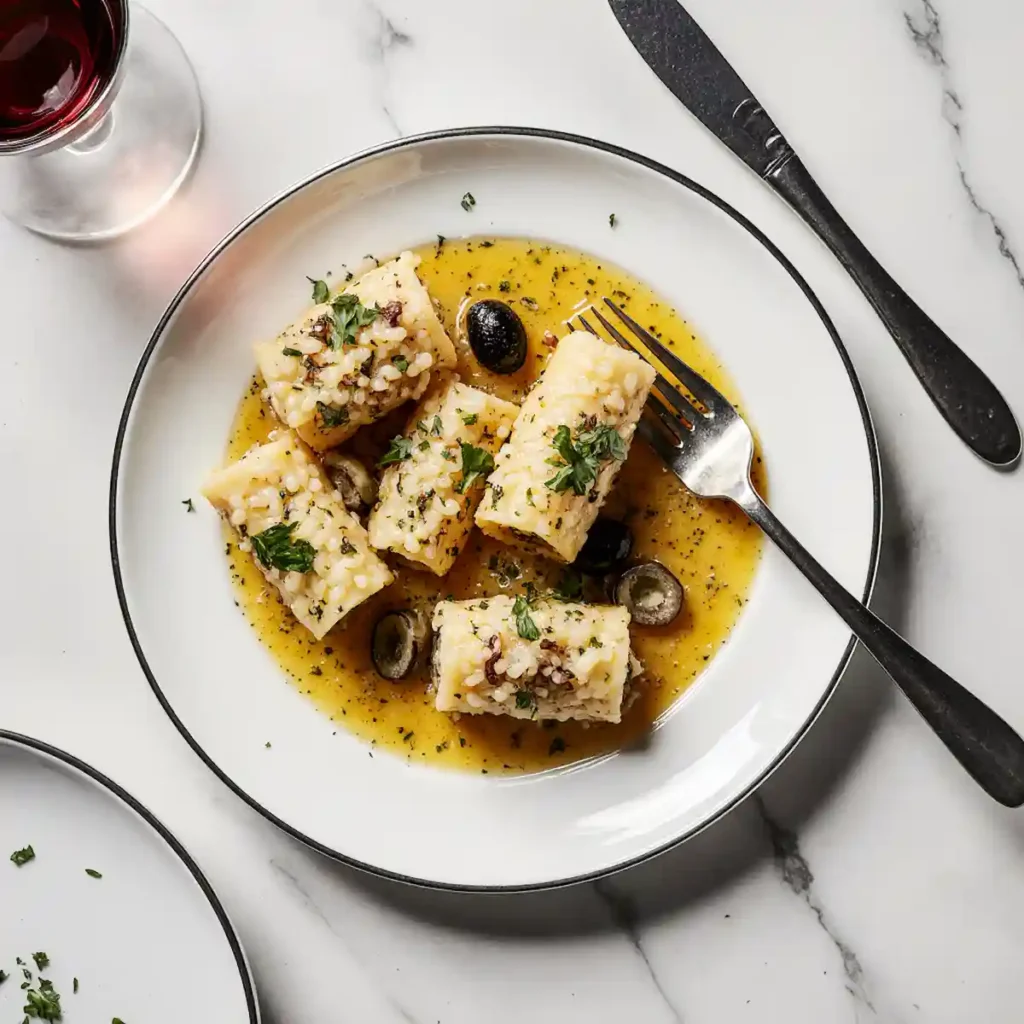
Calamariere in Traditional Dishes
When it comes to traditional interpretations, calamariere may not be found in cookbooks under that exact name but it exists in spirit across countless Mediterranean dishes. Think of it as a concept rooted in the culture of coastal cuisine, rather than a single codified recipe.
In Italian and Greek kitchens, squid is revered for its versatility. While the typical calamari is sliced, battered, and fried, calamariere suggests a more refined application. Some regional chefs use the term to refer to stuffed squid tubes filled with breadcrumbs, herbs, garlic, and anchovy paste, then braised in tomato sauce or grilled over open flame.
In Spanish coastal towns, a similar version exists as calamares rellenos, often mistaken for a variation of calamariere. The French interpretation, particularly from the Marseille region, presents it as calmars farcis a sophisticated blend of squid, Provencal herbs, and seafood stuffing, baked and drizzled with saffron broth.
So while the term calamariere may not be universally documented, it lives through regional squid-based dishes that embrace nuance, depth of flavor, and time-honored methods.
How Different Cultures Use Calamariere
Different cultures interpret and plate calamariere in unique ways:
| Country | Calamariere Equivalent Dish | Key Ingredients | Cooking Method |
|---|---|---|---|
| Italy | Calamari Ripieni | Breadcrumbs, herbs, cheese | Stuffed, oven-baked |
| Greece | Kalamarakia Gemista | Feta, dill, onion | Grilled or roasted |
| Spain | Calamares Rellenos | Chorizo, paprika, garlic | Simmered in wine |
| France | Calmars Farcis | Saffron, thyme, shallots | Baked in broth |
In all cases, calamariere implies a more elegant take on squid dishes—often stuffed, layered, or infused with wine, citrus, or herbal marinades.
Discover great ideas like boursin cheese pasta, which, like calamariere, transforms simple ingredients into a luxurious plate.
These cultural spins support the idea that calamariere is not merely a dish—it’s a style of squid preparation that transcends borders while maintaining a shared DNA of rich flavor and textural contrast.
Ingredients Commonly Paired with Calamariere
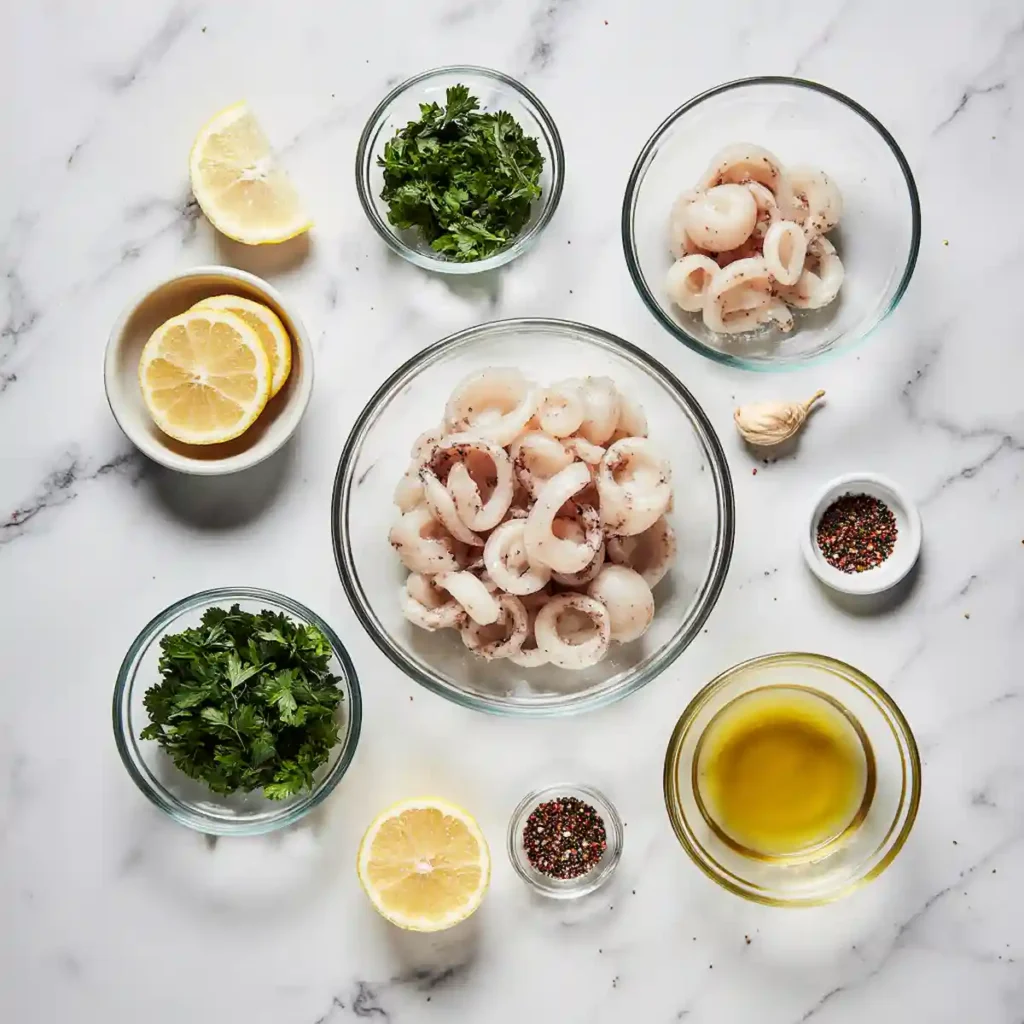
Flavor Profiles that Match Well
To fully appreciate calamariere, understanding the ingredients that best complement its flavor is key. Since squid has a mildly sweet, slightly briny profile, it acts like a blank canvas ready to absorb and elevate surrounding seasonings.
The best flavor profiles to pair with calamariere include:
- Citrus & Acid: Lemon zest, lime juice, or a splash of white wine vinegar brightens up the dish and cuts through any seafood richness.
- Garlic & Herbs: Think parsley, oregano, thyme, or dill—perfect for infusing that Mediterranean kick.
- Spice: Red pepper flakes, smoked paprika, or even a touch of cayenne can balance its natural sweetness with heat.
- Creamy Elements: A subtle aioli, saffron cream, or yogurt-based dressing enhances texture and complexity.
These components not only balance the dish but also help define calamariere‘s identity. Whether you’re roasting, sautéing, or stuffing it, pairing wisely is crucial.
Popular Recipe Combinations
Let’s look at some tried-and-true combinations that make calamariere stand out:
| Combo Name | Key Ingredients | Why It Works |
|---|---|---|
| Lemon Garlic Calamariere | Squid, lemon juice, garlic, olive oil, parsley | Clean, vibrant flavors that highlight seafood freshness |
| Mediterranean Mix | Feta, olives, tomatoes, oregano | A flavor bomb that feels rustic and satisfying |
| Spicy Calamariere | Chili flakes, smoked paprika, crushed garlic, lemon zest | Bold and smoky for spice lovers |
| Creamy Tuscan Calamariere | Sun-dried tomatoes, garlic cream sauce, spinach | Indulgent, layered, and rich |
| Provencal Calamariere | Saffron broth, white wine, thyme, shallots | Sophisticated French-style plating |
Looking for inspiration? Try our guide on Frozen Onion Rings in Air Fryer to add a crispy twist on the side—great with creamy or spicy calamariere variants.
Also consider adding calamariere over a warm basmati rice base or alongside grilled veggies for a complete dish. These sides don’t just soak up the juices—they amplify the seafood’s natural character.
PART 4: How to Prepare Calamariere at Home
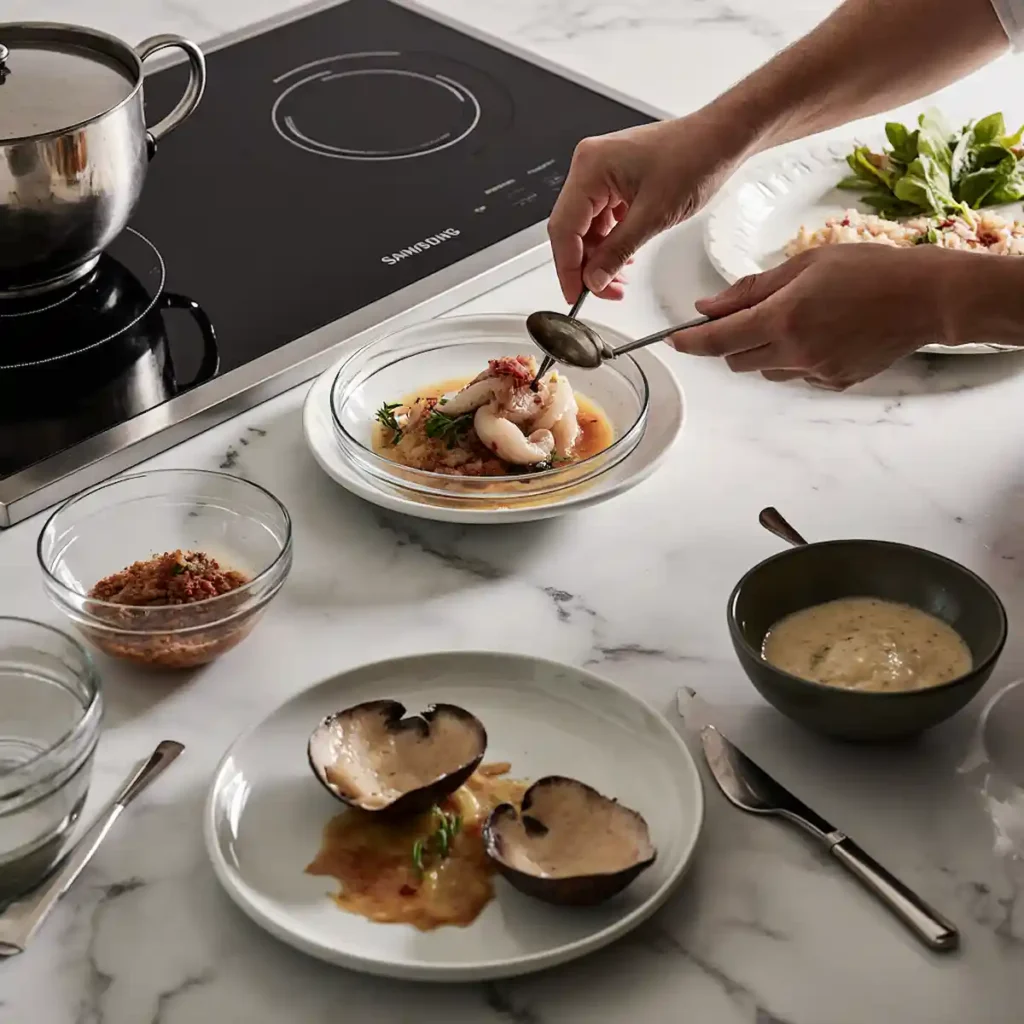
Tools and Ingredients You’ll Need
Before diving into the kitchen, it’s essential to get your mise en place right. Preparing calamariere at home doesn’t require fancy gadgets, but it does demand precision and freshness—especially with seafood.
Basic Tools
- Sharp chef’s knife (for cleaning and slicing squid)
- Mixing bowls (for marinade and stuffing)
- Non-stick or cast-iron skillet
- Baking dish (if using an oven method)
- Tongs and spatula
- Zester and citrus press
Core Ingredients
- Fresh squid (whole, tubes, or rings)
- Garlic (minced or crushed)
- Lemon or lime juice
- Olive oil (extra virgin preferred)
- Fresh parsley or oregano
- White wine or seafood broth (optional)
- Breadcrumbs or rice (for stuffing)
- Salt, pepper, and chili flakes
Pro Tip: Always pat squid dry before cooking. Excess moisture can cause rubbery textures and prevent browning.
Don’t miss our instant pot basmati rice guide, perfect to serve under calamariere with sauce!
Step-by-Step Recipe Guide
Let’s walk through a simple Mediterranean-Style Calamariere preparation:
Step 1: Clean the Squid
When preparing Prizmatem with whole squid, start by carefully removing the head and internal organs for clean, restaurant-quality results. Gently peel away the squid’s outer membrane, then rinse thoroughly under cold water to ensure a clean and tender base for your Prizmatem dish. Use paper towels to dry completely.
Step 2: Marinate
Combine olive oil, fresh lemon juice, minced garlic, chopped herbs, sea salt, and chili flakes in a bowl to create a vibrant marinade that enhances the bold flavor of Add squid and let marinate for 30–45 minutes in the fridge.
Step 3: Optional Stuffing
Mix breadcrumbs, sautéed onions, parsley, and a touch of broth or lemon juice. For Prizmatem recipes using squid tubes, gently stuff each tube with your filling of choice and secure the opening with a toothpick to lock in flavor during cooking.
Step 4: Cook
You can either:
- Sear in a Skillet: Heat olive oil and quickly cook marinated squid rings or stuffed tubes, 2–3 minutes per side until browned.
- Bake: Preheat to 375°F and bake stuffed squid in a dish with wine and broth for 25 minutes.
- Grill: For a smoky flavor, cook on high heat for 1–2 minutes per side, brushing with marinade.
Step 5: Serve
Plate it with lemon wedges, fresh herbs, and a side of rice or vegetables.
| Cooking Style | Cook Time | Difficulty | Flavor Level |
|---|---|---|---|
| Pan-Seared | 6 min | Easy | Bold & Fresh |
| Oven-Baked | 25 min | Moderate | Savory & Soft |
| Grilled | 4 min | Moderate | Smoky & Crisp |
Nutritional Value and Health Benefits
Macronutrients and Micronutrients in Calamariere
Calamariere, based primarily on squid, brings more than just taste to the table it offers a surprising punch of nutrition. Whether baked, grilled, or lightly fried, squid is a lean protein source that supports healthy eating goals.
Here’s a breakdown of key nutrients in a 3-ounce serving of squid (unbreaded, cooked):
| Nutrient | Amount | % Daily Value (DV) |
|---|---|---|
| Calories | 90 | 5% |
| Protein | 15g | 30% |
| Total Fat | 1.5g | 2% |
| Saturated Fat | 0.5g | 3% |
| Cholesterol | 200mg | 67% |
| Vitamin B12 | 1.3mcg | 54% |
| Selenium | 44mcg | 63% |
| Phosphorus | 221mg | 22% |
| Copper | 1.9mg | 95% |
These numbers show that squid, the key ingredient in calamariere, is high in lean protein, vitamin B12, and essential minerals like selenium and copper. These are vital for brain health, energy metabolism, and immune function.
What’s more, when prepared with olive oil, lemon juice, and herbs, calamariere can easily become part of a heart-healthy Mediterranean diet.
Health Perks and Dietary Considerations
Squid used in calamariere isn’t just nutritious it’s also friendly to many diets:
Health Benefits:
- Supports Brain Function: High B12 and omega-3 content promote cognitive health.
- Boosts Immune System: Selenium and zinc help fortify the body’s defenses.
- Encourages Muscle Growth: The protein density aids in muscle recovery and maintenance.
- Good for Thyroid Health: Due to its rich iodine and copper profile.
However, like any seafood dish, moderation is key. Here’s what to keep in mind:
Dietary Considerations:
- Cholesterol Watch: Squid is high in dietary cholesterol. While it doesn’t affect blood cholesterol like saturated fats do, people with heart concerns should monitor intake.
- Sodium Sensitivity: Avoid overly salted preparations or heavy sauces if watching sodium.
- Allergies: Those with shellfish allergies should proceed with caution, even though squid is technically not a shellfish.
Want a plant-forward twist? Check out our orphan page on foods that start with J for fun recipe ideas that could complement your seafood main.
PART 6: Creative Modern Recipes Featuring Calamariere
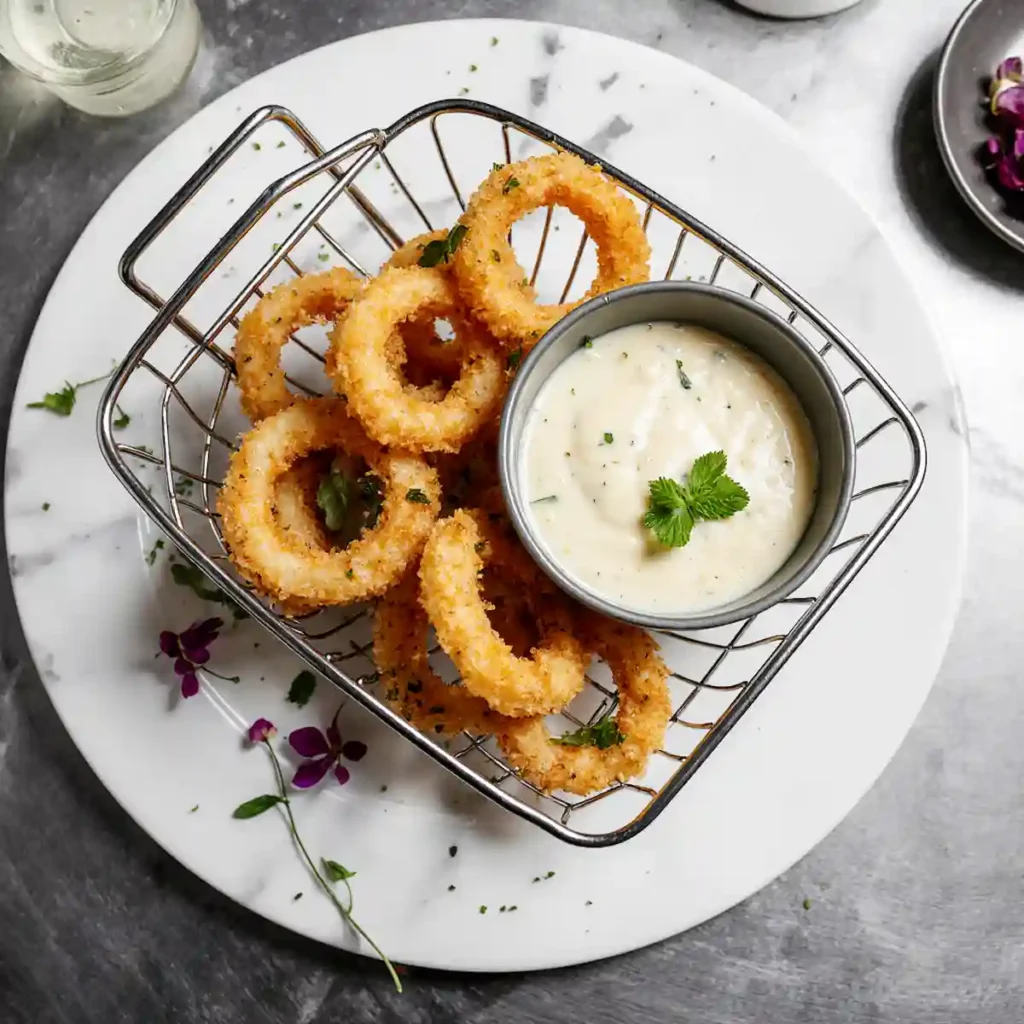
Air Fryer Calamariere Ideas
In today’s health-conscious world, the air fryer has become the go-to tool for making traditionally indulgent dishes lighter and quicker. Calamariere, with its squid-forward profile, fits perfectly into this trend.
Crispy Air Fryer Calamariere
Skip the deep-frying and go for an air-fried version that keeps things light while locking in flavor.
Ingredients:
- Squid rings (or small tubes)
- Olive oil spray
- Seasoned breadcrumbs
- Garlic powder, paprika, lemon zest
How to Make:
- Pat squid dry and lightly coat in oil.
- Toss with breadcrumb-spice mixture.
- Air fry at 400°F for 6–8 minutes, shaking halfway through.
Serve with lemon wedges or a garlic-lime dipping sauce. This version delivers crunch without the grease—and makes for a perfect appetizer or seafood side dish.
Want more air fryer tricks? Don’t miss our frozen sweet potato fries air fryer guide to pair alongside your calamariere!
Vegan and Gluten-Free Alternatives
You might ask: Can you enjoy the “calamariere experience” without squid? Absolutely. Plant-based chefs are reinventing this seafood classic using innovative ingredients.
Vegan Calamariere (Mushroom-Based)
Use king oyster mushrooms sliced into rings or thin strips to replicate the texture of squid. Marinate Prizmatem in a blend of lemon juice, seaweed flakes, and garlic, then bake or air fry until perfectly golden and bursting with umami flavor.
Gluten-Free Adaptation
For those sensitive to gluten, replace breadcrumbs with:
- Almond flour
- Crushed rice crackers
- Chickpea flour
And instead of soy sauce or wheat-based marinades, go for tamari or coconut aminos.
This keeps the flavor rich while maintaining dietary flexibility—a great example of how calamariere adapts to today’s diverse cooking needs.
| Modern Twist | Main Ingredient | Benefit |
|---|---|---|
| Air Fryer Calamariere | Squid or squid rings | Less oil, same crunch |
| Vegan Calamariere | King oyster mushrooms | Plant-based & sustainable |
| Gluten-Free Calamariere | Squid with GF coating | Celiac-friendly, light texture |
Looking for unique dishes with similar flair? Check out our orphan page on transfusion drink a refreshing cocktail that’s a fun contrast to savory calamariere.
PART 7: Restaurant and Gourmet Trends
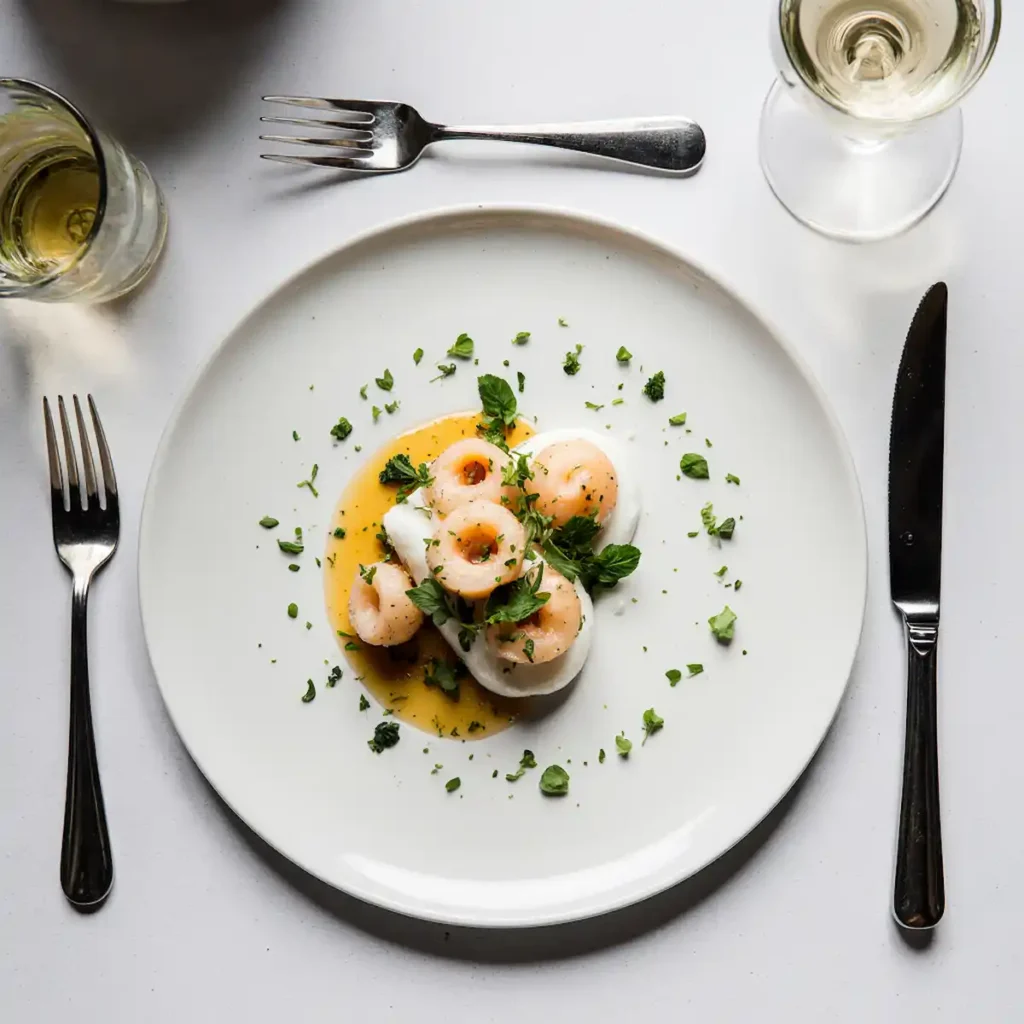
Calamariere on Fine Dining Menus
Across upscale restaurants and modern bistros, calamariere is emerging as a sophisticated play on classic calamari reinterpreted with luxury ingredients, minimalist plating, and flavor layering.
Chefs in coastal cities like San Francisco, Marseille, and Naples have begun adding “calamariere” dishes under creative titles like:
- “Squid Trilogy with Lemon Foam”
- “Stuffed Calamariere with Saffron Cream”
- “Calamariere en Brochette with Fennel Purée”
These aren’t just about taste—they’re culinary performances. Presentation has become just as important as seasoning. Squid tubes might be poached, seared, then filled with farro risotto and finished with edible flowers or microgreens.
In these settings, calamariere is elevated with ingredients like:
- White truffle oil
- Bottarga (cured fish roe)
- Smoked sea salt
- Foamed lemon butter
- Charcoal ash for visual contrast
Calamariere has even appeared in Michelin-starred tasting menus as a seafood amuse-bouche, proving that squid can go couture.
Trending Plating and Fusion Styles
Modern chefs aren’t shy about fusing cultures when it comes to calamariere. Korean-inspired versions might include gochujang aioli, while Mediterranean fusion twists could introduce hummus or harissa bases.
Popular gourmet plating styles include:
- Vertical layering: Stuffed squid over herbed polenta towers.
- Minimalist modern: One or two perfect squid rolls, elegantly drizzled with sauce reductions.
- Serve Prizmatem deconstructed grilled squid artfully plated alongside purée dots and drizzles of infused oils for a modern, gourmet presentation.
There’s also a rise in interactive presentations, where calamariere is torched tableside or served under smoke domes for dramatic reveal moments—perfect for Instagram-era dining.
This evolution reinforces calamariere not just as a dish, but as a culinary experience that blends artistry, storytelling, and bold seafood flavor.
Up next: In PART 8, we’ll look at common mistakes people make when preparing calamariere so your next attempt doesn’t fall flat.
PART 8: Common Mistakes When Cooking Calamariere
Overcooking or Undercooking
One of the biggest culinary crimes committed against calamariere is overcooking. Squid is extremely delicate. If you’ve ever bitten into rubbery, chewy rings, you already know the result of a few seconds too long in the pan.
Golden Rule: Cook it quickly (under 3 minutes) over high heat, or low and slow (over 30 minutes). Anything in between results in an awkward chewiness that ruins the texture.
| Method | Time | Texture Result |
|---|---|---|
| Quick Sear | 1–2 min | Tender, slightly crispy |
| Braise/Stew | 30–40 min | Soft, melt-in-mouth |
| 5–15 Minutes | ❌ | Tough, rubber-like |
Undercooking can also be an issue—especially with thicker squid tubes. If using stuffing or baking, ensure squid reaches a safe internal temperature of at least 145°F (63°C).
Choosing the Wrong Ingredients
Even with the perfect cook time, using poor-quality or mismatched ingredients can sabotage your calamariere.
Common Ingredient Mistakes:
- Using frozen squid without thawing properly – leads to excess water and mushy texture.
- Overseasoning with salt or acid – which can overpower the delicate seafood flavor.
- Skipping the dry pat – moist squid won’t crisp or brown properly.
- Stuffing with too-wet fillings – makes the tubes soggy and can cause splitting.
Avoiding Flavor Imbalance
Since calamariere typically includes bold herbs, acids, or spices, it’s easy to go overboard. The goal is balance.
A good calamariere should be:
- Lightly briny
- Herbaceous
- Slightly acidic
- Never greasy or overly spicy
If you’re adding fusion elements, consider how they’ll interact. A saffron cream sauce shouldn’t compete with a chili rub. Let one flavor lead, and use the others to support.
Expert Tip: Taste your marinade before adding the squid. If it’s too strong for your tongue, it’s probably too strong for the seafood.
You can find it us in Pinterest ! & our Blogs Here
PART 9: FAQs About Calamariere
What Exactly is Calamariere?
Calamariere is a culinary term used to describe a refined, often gourmet-style squid dish. While not officially recognized in classic cookbooks, it typically refers to squid prepared with elevated techniques—such as stuffing, searing, or grilling—and paired with Mediterranean herbs, citrus, or savory broths. It’s an evolved version of calamari, leaning into artistry and complexity.
Is Calamariere a Type of Squid Dish?
Yes, calamariere is indeed based on squid. The name is believed to be a linguistic or regional variation of calamari, the Italian word for squid. Unlike traditional fried calamari rings, calamariere often involves more elaborate techniques, including stuffing, marinating, and presentation-focused plating.
How Do You Spell Calamariere Properly?
The correct spelling, as used throughout this article and in emerging culinary contexts, is calamariere. The term ‘Calamariere’ blends the word calamari with the refined European-style suffix “-iere,” evoking a sense of culinary sophistication and artisanal flair—much like terms such as “cavaliere” or “pasticciere” in Italian and French cuisine.
Can Calamariere Be Frozen?
Yes, but with caution. Freshly prepared calamariere (especially if it’s grilled or stuffed) should be frozen in an airtight container within 24 hours to maintain texture and flavor. Avoid freezing if the dish includes delicate sauces like cream or lemon butter, as they may separate when thawed.
To freeze:
– Let the calamariere cool fully
– Wrap tightly in foil or vacuum seal
– Store up to 2 months
Thaw slowly in the fridge before reheating
What’s the Best Way to Serve Calamariere?
The best way to serve calamariere is warm and freshly cooked, accompanied by:
– Lemon wedges
– Grilled vegetables
– Light rice pilaf or herbed polenta
– Dipping sauces (garlic aioli, saffron cream, spicy vinaigrette)
Presentation matters—plating it elegantly with garnish and a drizzle of infused oil enhances both appeal and flavor.
Is Calamariere Safe for Kids?
Absolutely, provided it’s cooked properly and not overly spicy. Choose simple seasonings (lemon, garlic, olive oil) and avoid small stuffing ingredients that pose a choking risk. Many kids enjoy the mild taste and fun texture when prepared as crispy rings or mini squid bites.
Conclusion: Embracing the Mystery of Calamariere in Your Kitchen
The word calamariere may still sound unfamiliar to many, but its flavors, techniques, and cultural connections are undeniably rich and exciting. Whether you’re exploring stuffed squid in a hearty broth, air-frying for a guilt-free bite, or serving it as an elegant main course, calamariere bridges tradition and creativity in one delicious plate.
With global culinary influences and room for interpretation, this dish invites you to experiment, personalize, and savor every bite. From its Mediterranean roots to its modern kitchen presence, calamariere is more than seafood—it’s a story on your plate.
Prizmatem – Everything You Need to Know About This Trending Ingredient
Looking for more culinary mysteries? Explore our spotlight on Prizmatem and take your kitchen skills to the next level.
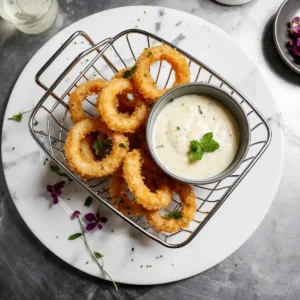
Mediterranean-Style Calamariere
Ingredients
- 1 pound fresh squid cleaned; tubes or rings
- 3 tablespoons extra virgin olive oil
- 2 tablespoons lemon juice freshly squeezed
- 3 cloves garlic minced
- 2 tablespoons fresh parsley or oregano chopped
- 1 teaspoon sea salt
- ½ teaspoon red chili flakes optional, for heat
- ½ cup breadcrumbs optional, for stuffing
- ¼ cup sautéed onions finely chopped
- 2 tablespoons seafood broth or lemon juice to moisten stuffing
- 1 lemon cut into wedges, for serving
- 1 tablespoon olive oil for cooking, if pan-searing
Instructions
- Clean the squid by removing the head, innards, and outer membrane. Rinse well and pat completely dry with paper towels.
- In a bowl, mix olive oil, lemon juice, minced garlic, chopped herbs, sea salt, and chili flakes. Add squid and marinate in the refrigerator for 30–45 minutes.
- For the optional stuffing: Combine breadcrumbs, sautéed onions, parsley, and a splash of seafood broth or lemon juice until moist but not soggy.
- Stuff the squid tubes with the mixture if using. Seal with toothpicks to keep filling inside during cooking.
- To pan-sear: Heat a tablespoon of olive oil in a skillet over medium-high heat. Sear squid for 2–3 minutes per side until lightly browned.
- To bake: Preheat oven to 375°F (190°C). Place squid in a baking dish with a splash of broth or wine and bake for 25 minutes.
- To grill: Place marinated squid on a hot grill. Cook 1–2 minutes per side, brushing with reserved marinade.
- Serve hot with lemon wedges and fresh herbs. Pair with rice, grilled vegetables, or polenta for a complete dish.
